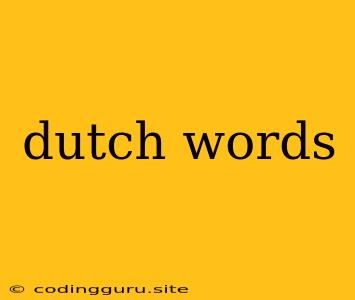Delving into the World of Dutch Words
Learning a new language can be an enriching experience, and Dutch, with its unique sounds and intriguing vocabulary, offers a fascinating journey. But where do you start? How do you navigate the world of Dutch words and make them your own?
This article will explore the beauty and complexities of the Dutch language and guide you through some of its most common words. We'll uncover the origins of some of these Dutch words, delve into their meanings, and explore their use in everyday conversation. Let's embark on this linguistic adventure together!
The Basics: Common Dutch Words and Phrases
To start your Dutch language journey, here are some fundamental Dutch words and phrases you can use:
- Hallo: Hello
- Goedendag: Good day
- Goedemorgen: Good morning
- Goedenavond: Good evening
- Bedankt: Thank you
- Graag gedaan: You're welcome
- Ja: Yes
- Nee: No
- Alstublieft: Please
- Dank u wel: Thank you very much
- Tot ziens: See you later
- Tot morgen: See you tomorrow
- Dag: Goodbye
These phrases form the building blocks of any conversation, allowing you to greet someone, express gratitude, and say farewell in a polite and respectful manner.
Beyond the Basics: Exploring Dutch Vocabulary
As you venture deeper into the world of Dutch words, you'll encounter a rich tapestry of language, with unique expressions and idioms. Here are some examples:
1. "Gezellig"
This is a quintessential Dutch word that embodies the concept of cozy, warm, and comfortable. It describes a feeling of togetherness and contentment, often associated with spending time with loved ones.
2. "Lekker"
This versatile Dutch word translates to "delicious" but extends beyond food to encompass anything enjoyable or pleasant. You can use it to describe a beautiful day, a good book, or even a comfortable chair.
3. "Mooi"
This means "beautiful" in Dutch and can be applied to various aspects of life, from a breathtaking sunset to a piece of art. It's a word that captures the aesthetic appreciation of the Dutch culture.
4. "Smaak"
This Dutch word translates to "taste," but it also holds a broader meaning. It signifies preference or a personal sense of style, often used in expressions like "to your taste" or "have good taste."
5. "Zeg"
This versatile Dutch word can be used in several contexts. It can mean "say," "look," or "listen" and serves as a way to get someone's attention or to express surprise.
6. "Koffie" & "Thee"
No exploration of Dutch words is complete without mentioning the importance of coffee and tea in Dutch culture. "Koffie" is coffee, and "thee" is tea, both staples of everyday life and social gatherings.
A Journey into Dutch Pronunciation
Dutch pronunciation can be challenging for learners, but mastering it will greatly enhance your understanding and fluency. Here are some helpful tips:
1. The "G" Sound: The "g" sound in Dutch can be tricky. It's often pronounced like the "ch" in "Bach" or the "ch" in "loch."
2. The "IJ" Diphthong: This diphthong sounds like the "eye" in "eye." It's a unique sound not found in many other languages.
3. The "OU" Diphthong: This diphthong sounds similar to the "ow" in "cow." It can be tricky for English speakers to differentiate from the "ou" sound in "house."
4. The "EU" Diphthong: This diphthong sounds like the "oy" in "boy." It's another unique sound not found in many other languages.
5. Stressed Syllables: In Dutch, the stress typically falls on the first syllable of a word.
The Power of Dutch Idioms
Dutch idioms offer a glimpse into the cultural nuances and humor of the language. Here are some examples:
1. "Iemand in de maling nemen": This idiom literally translates to "take someone in the mill" and means "to fool someone."
2. "Een schot voor de boeg": This idiom literally translates to "a shot for the bow" and means "a warning."
3. "Een gat in de markt": This idiom literally translates to "a hole in the market" and means "a niche market."
4. "Een berg aan werk": This idiom literally translates to "a mountain of work" and means "a lot of work."
5. "De kat uit de boom kijken": This idiom literally translates to "look at the cat out of the tree" and means "to wait and see."
Learning Resources: How to Improve Your Dutch
If you're eager to delve deeper into the world of Dutch words, several excellent resources can help you along your language learning journey:
1. Language Learning Apps: Duolingo, Babbel, Memrise, and Rosetta Stone are popular apps that offer structured lessons, interactive exercises, and gamified learning experiences.
2. Online Dictionaries: Online dictionaries like WordReference and Van Dale are invaluable resources for looking up Dutch words, their meanings, and pronunciation.
3. Language Exchange Communities: Websites like HelloTalk and Tandem connect you with native Dutch speakers, providing opportunities for conversation practice and cultural exchange.
4. Immersion Programs: Immersion programs offer a structured and intensive approach to language learning. They involve spending time in the Netherlands, interacting with local people, and immersing yourself in the language and culture.
5. Books and Courses: Numerous textbooks and online courses are available that focus on learning Dutch. These resources provide a comprehensive approach to grammar, vocabulary, and pronunciation.
Conclusion
Learning Dutch words can be a fulfilling and rewarding experience. By exploring the language's rich vocabulary, its unique pronunciation, and its fascinating idioms, you'll gain a deeper appreciation for Dutch culture and its people. Whether you're a beginner or an advanced learner, there are numerous resources available to support your journey, allowing you to unlock the beauty and power of the Dutch language.
